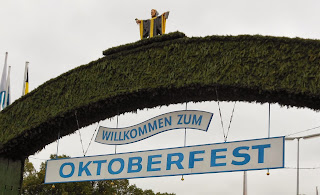Nothing
gets you into the holiday spirit more than a classic German Weihnachtsmarkt
(Christmas Market). Whether you enjoy ice skating in a Platz surrounded by
brightly lit Christmas trees or sipping a hot drinking with friends, the
markets are the place to be during the holiday season. The Christmas Markets
are
 full of delicious, traditional German foods and drinks such as Lebenkuchen
(a soft gingerbread), Kartoffelpüffer (potato pancakes), heiße Maroni (roasted
chestnuts), all types of Wursts, and of course glühwein. Glühwein is hot,
mulled wine that is served around during the Christmas season. Glühwein,
translated into English as “glowing wine”, gives the impression that the wine
is literally glowing when it is hot. Glühwein is often served in colorfully
decorated cups, which can either be kept as a fun souvenir or can be returned
for money back. Each Christmas has its own glühwein cup or, depending on the
size of the market, has several different cup designs. Collecting a cup from
all the markets you visit can be a fun way of remembering the great times you
had at each market. If you’re looking for glühwein with a twist, try the
Feuerzeugbowle. Feuerzeugbowle is glühwein with sugar and rum. The glühwein is
cooked in large cauldrons that have half cylinder pipes with holes drilled into
the bottom hanging over the cauldrons. Large sugar cones are placed into the
pipes and dowsed in rum. They are then lit on fire. This not only wows the
crowd but also melts the sugar allowing it the drips through the holes and into
the wine. The alcohol in the rum is burnt off by the flames but the flavor
remains embedded in the melted sugar.
full of delicious, traditional German foods and drinks such as Lebenkuchen
(a soft gingerbread), Kartoffelpüffer (potato pancakes), heiße Maroni (roasted
chestnuts), all types of Wursts, and of course glühwein. Glühwein is hot,
mulled wine that is served around during the Christmas season. Glühwein,
translated into English as “glowing wine”, gives the impression that the wine
is literally glowing when it is hot. Glühwein is often served in colorfully
decorated cups, which can either be kept as a fun souvenir or can be returned
for money back. Each Christmas has its own glühwein cup or, depending on the
size of the market, has several different cup designs. Collecting a cup from
all the markets you visit can be a fun way of remembering the great times you
had at each market. If you’re looking for glühwein with a twist, try the
Feuerzeugbowle. Feuerzeugbowle is glühwein with sugar and rum. The glühwein is
cooked in large cauldrons that have half cylinder pipes with holes drilled into
the bottom hanging over the cauldrons. Large sugar cones are placed into the
pipes and dowsed in rum. They are then lit on fire. This not only wows the
crowd but also melts the sugar allowing it the drips through the holes and into
the wine. The alcohol in the rum is burnt off by the flames but the flavor
remains embedded in the melted sugar. Another
great feature of the markets is the artisan crafts. The markets are certainly a
great place to get any holiday shopping done. A highlight of the artisan crafts
is the woodwork. There are booths upon booths filled with handmade wooden
gifts. A big hit at the markets are the wooden ornaments. Many of the ornaments
have religious images, such as Mary with baby Jesus, but there are plenty of
non-religious ornaments too, such as intricate snowflakes and happy snowmen. If
you are searching for a present for a young child, the markets are definitely
the place to look. There are a lot of handmade wooden toys for small children.
There are mobiles with colorfully painted animals for infants or push toys for toddlers.
You can even find little wooden dolls and toy soldiers. If you are religious there
are plenty of religious icons for sale. Many booths sell wooden nativity pieces
and sets.
Another
great feature of the markets is the artisan crafts. The markets are certainly a
great place to get any holiday shopping done. A highlight of the artisan crafts
is the woodwork. There are booths upon booths filled with handmade wooden
gifts. A big hit at the markets are the wooden ornaments. Many of the ornaments
have religious images, such as Mary with baby Jesus, but there are plenty of
non-religious ornaments too, such as intricate snowflakes and happy snowmen. If
you are searching for a present for a young child, the markets are definitely
the place to look. There are a lot of handmade wooden toys for small children.
There are mobiles with colorfully painted animals for infants or push toys for toddlers.
You can even find little wooden dolls and toy soldiers. If you are religious there
are plenty of religious icons for sale. Many booths sell wooden nativity pieces
and sets.
Most German
cities, especially the larger cities, have a Christmas market. It is definitely
worth your while to visit as many as possible. Each market is unique with its
own charms and own things to offer.



















